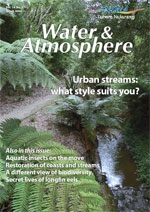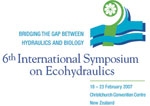PDF of this article (84 KB)


Workshop on iron-enrichment studies
The productivity of the ocean is driven by the carbon fixed during photosynthesis by microscopic plants called phytoplankton. These plants use sunlight and nutrients, such as nitrate, to fuel photosynthesis. However, phytoplankton grow poorly in about a third of the ocean, even though there are abundant plant nutrients. The existence of these so-called high-nitrate low-chlorophyll (HNLC) waters has puzzled ocean scientists for decades.
In 1990, it was hypothesised that phytoplankton in HNLC waters were anaemic and lacked enough iron to grow at faster rates. This idea has been tested in large-scale experiments by adding iron (dissolved in seawater) to the ocean over areas of 50 km2 and then monitoring the response of the phytoplankton. Satellite imagery shows that phytoplankton become more productive as a result. Twelve of these experiments – called iron-enrichment studies – have been conducted over the last decade in polar, subpolar, and tropical HNLC waters. NIWA has led three of these experiments since 1999.
Last November, NIWA hosted and co-sponsored a workshop in Wellington to synthesise the findings of these iron-enrichment studies, and to debate how the design of such studies could be improved in the future. The five-day meeting, organised by a new international programme called SOLAS (Surface Ocean-Lower Atmosphere Study), brought together 19 scientists from nine countries. The name of the workshop was 'SOLAS Synthesis of Mesoscale Iron-Enrichment Studies'.
Participants concurred that the iron-enrichment studies have conclusively tested the iron hypothesis and solved the puzzle of why the productivity of some ocean waters is lower than it could be. This has led to a better understanding of the biological functioning of HNLC waters, which can now be represented more accurately in mathematical model simulations. The global iron supply to the oceans is thought to have been greater in the geological past (during the ice ages), and the world ocean may have been more productive then; this has implications for variations in global climate, which is known to be linked to ocean productivity.
The final two days of the meeting provided the opportunity to decide the outstanding questions that must be addressed if we are to improve our understanding of the role iron supply plays in setting ocean productivity and affecting global climate. The participants will co-author a short review paper on findings of the workshop, to be submitted to an international journal.
For further information, contact: Dr Mike Harvey, 0-4-386 0308, [email protected] Dr Cliff Law, 0-4-386 0478, [email protected] or Dr Philip Boyd, 0-3-479 5249, [email protected]
Hydraulics meets biology in Christchurch next year

The 6th International Symposium on Ecohydraulics will be held in Christchurch in February 2007, with an expected attendance of more than 350 professionals working in hydraulic and environmental research and applications.
The symposium’s focus on bridging the knowledge gap between hydraulics and biology is relevant to national problems with water allocation. Though New Zealand receives a generous amount of rainfall, the high mountain ranges through the central parts of both North and South Island mean that precipitation and associated river flows are very unevenly spread.
Water allocation is seen as one of the most significant threats to both sustainable economic development and freshwater environments in New Zealand. Ever-increasing demands for water raise the fundamental question: how much water do freshwater ecosystems need to maintain ecological and recreational values?
The symposium will incorporate new ideas and encourage the development of interdisciplinary methods to help resolve the conflicts arising from increasing water use and environmental demands.
Session themes will include:
- Hydraulic habitat suitability
- Solute and nutrient transport and exchange
- Sediment-flow interactions and effects on habitat
- Hydraulic habitat and biological modelling
- Flow regime assessment
- Fish passage/screening
- Restoration – hydraulic/water quality/biotic
- Water management
The biennial ecohydraulics symposia are sponsored by the International Association of Hydraulic Engineering and Research (IAHR) and the International Modelling Group. The local organising committee for the sixth symposium is co-chaired by NIWA scientists Ian Jowett and Barry Biggs.
For further information, visit the website: www.conference.co.nz/ecohydraulics2007
